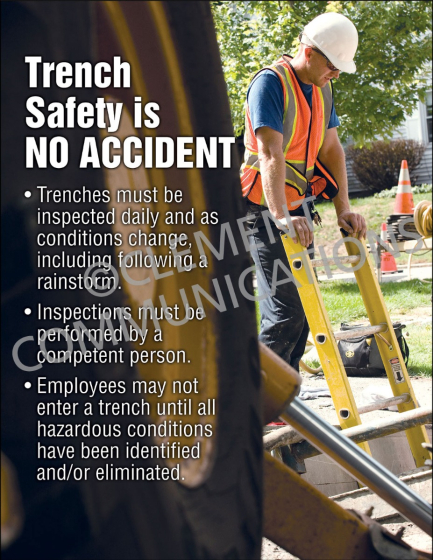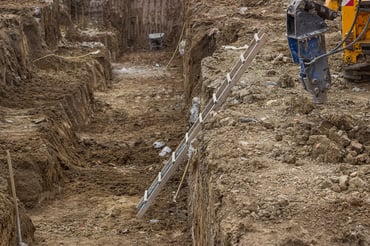Ensuring safety while using a ladder in a trench is crucial. Trench work comes with unique risks.
Safety measures must be followed to avoid accidents. Using a ladder in a trench involves specific guidelines. These guidelines ensure stability and prevent falls. Workers should understand these rules to stay safe. This blog will cover the essential points. Knowing them can make a difference.
Stay informed, stay safe.
Importance Of Ladder Safety
Using a ladder in a trench can be risky. Ensuring ladder safety is crucial. It can prevent accidents and injuries. Proper ladder use protects workers. It also ensures a safe work environment. Understanding the risks and standards is key. This section will cover common risks and safety standards.
Common Risks
Ladders in trenches pose several risks. Workers must be aware of these. Common risks include:
- Slips and Falls: Wet or uneven surfaces can cause slips.
- Ladder Collapse: Incorrect setup can lead to a collapse.
- Trench Cave-Ins: Trenches can collapse, trapping workers.
- Electrocution: Ladders near power lines pose a risk.
Understanding these risks is vital. It helps in taking preventive measures.
Safety Standards
There are specific safety standards for ladder use in trenches. These include:
- Proper Placement: Place the ladder on stable ground.
- Securing the Ladder: Ensure the ladder is secure and won’t move.
- Using the Right Ladder: Choose a ladder suitable for the task.
- Regular Inspections: Check the ladder for defects before use.
- Training: Workers must be trained in ladder safety.
Following these standards ensures safety. It reduces the risk of accidents.
Below is a table summarizing key safety standards:
| Standard | Description |
|---|---|
| Proper Placement | Place the ladder on stable ground. |
| Securing the Ladder | Ensure the ladder is secure and won’t move. |
| Using the Right Ladder | Choose a ladder suitable for the task. |
| Regular Inspections | Check the ladder for defects before use. |
| Training | Workers must be trained in ladder safety. |
Adhering to these standards is essential. It ensures a safe working environment.

Credit: www.clement.com
Choosing The Right Ladder
When working in a trench, selecting the right ladder is crucial. Safety and efficiency depend on it. Knowing the various types of ladders and material options can help you make an informed decision.
Types Of Ladders
Different types of ladders suit various tasks. Here are some common options:
- Step Ladders: Ideal for short heights. They are self-supporting.
- Extension Ladders: Perfect for higher areas. They provide more reach.
- Platform Ladders: Offer a larger standing area. Great for long tasks.
Each type has its benefits. Consider the task at hand to choose the most suitable ladder.
Material Considerations
Ladders come in different materials, each with its own advantages:
| Material | Benefits |
|---|---|
| Aluminum | Lightweight, rust-resistant, and easy to carry. |
| Fiberglass | Non-conductive, strong, and durable. |
| Wood | Non-conductive and cost-effective. Heavier than other materials. |
Choosing the right material is key. Aluminum is great for portability. Fiberglass is best for electrical work. Wood is a budget-friendly option.
Make sure the ladder fits your specific needs. Safety should always be the top priority.
Preparing The Trench Site
Proper preparation of the trench site is essential for the safe use of a ladder. Ensuring the site is well-prepared can prevent accidents and injuries. Below are important steps to take when preparing a trench site.
Site Inspection
Before starting any work, conduct a thorough site inspection. Check the stability of the trench walls. Look for signs of weakness or potential collapse. Verify the depth and width of the trench. Ensure it meets safety regulations.
Inspect the surrounding area for potential hazards. This includes loose soil, water accumulation, and nearby structures. Document any concerns or issues found during the inspection. Address them before proceeding.
Clearing Obstacles
Clear all obstacles from the trench site. Remove debris, rocks, and tools. These can be tripping hazards. Ensure the ground around the trench is level and stable. This provides a safe base for the ladder.
Place warning signs around the trench to alert others of the danger. Use barriers to keep unauthorized personnel away. This minimizes the risk of accidents.
Consider the following checklist for clearing obstacles:
- Remove all debris and rocks
- Ensure ground stability around the trench
- Set up warning signs
- Install barriers to restrict access
In summary, preparing the trench site involves careful inspection and clearing of obstacles. These steps ensure a safe environment for ladder use.

Credit: www.ejprescott.com
Securing The Ladder
Using a ladder in a trench requires extra care. Ensuring the ladder is secure is crucial. Proper securing prevents accidents and injuries. Follow these steps to secure your ladder effectively.
Anchoring Techniques
Anchoring the ladder is the first step. Use strong, reliable materials for anchoring. Sandbags or concrete blocks work well.
- Place sandbags: Place heavy sandbags on both sides of the ladder base.
- Use stakes: Drive metal stakes into the ground. Attach the ladder to the stakes.
- Concrete blocks: Place heavy concrete blocks around the ladder base for stability.
Using Ladder Stabilizers
Ladder stabilizers add an extra layer of safety. They help balance the ladder and prevent slips.
- Attach stabilizers: Secure stabilizers to the top of the ladder. Make sure they are tight.
- Check stability: Test the ladder for stability before use.
- Adjust as needed: Adjust stabilizers if the ladder is not stable.
Proper anchoring and stabilizing ensure a secure ladder. Always check your ladder before use. Safety first!
Maintaining Ladder Stability
Maintaining ladder stability is crucial for safety when working in a trench. Proper stability prevents accidents and ensures a secure working environment. To achieve this, consider key factors such as level ground and proper use of ladder feet.
Checking For Level Ground
Before placing the ladder, ensure the ground is level. This is essential for ladder stability. Uneven ground can cause the ladder to tip over.
- Use a level tool to check the ground.
- Remove any debris or rocks.
- If the ground is soft, use a sturdy base or platform.
A table can also be useful to compare different leveling tools:
| Tool | Pros | Cons |
|---|---|---|
| Bubble Level | Easy to use | Not accurate on uneven surfaces |
| Laser Level | Highly accurate | More expensive |
| Water Level | Inexpensive | Requires more setup time |
Using Ladder Feet
Proper use of ladder feet enhances stability. Ladder feet should be firmly placed on the ground.
- Check that the feet are clean and dry.
- Make sure the feet are fully extended.
- Use rubber pads if the ground is slippery.
For extra stability, consider using ladder stabilizers. These add support and reduce the risk of slipping.
Remember, safety is paramount. Always check the ladder’s stability before use.

Credit: hsseworld.com
Training And Best Practices
Ensuring safety in a trench involves more than just equipment. Proper training and best practices are essential. Workers need to be prepared for various scenarios. This includes the correct use of ladders in trenches. Training helps prevent accidents and ensures a safe work environment.
Worker Training Programs
Effective worker training programs are crucial. They provide the knowledge and skills needed for safe operations. These programs should cover:
- Proper ladder placement in trenches
- Correct climbing techniques
- Identifying potential hazards
- Emergency procedures
Training should be comprehensive and practical. Workers should engage in hands-on sessions. This reinforces their learning and builds confidence.
Regular Safety Drills
Regular safety drills keep workers alert and prepared. Drills simulate real-life scenarios. This helps workers practice their response to emergencies. Key aspects of safety drills include:
- Evacuation procedures
- First-aid response
- Communication protocols
- Inspection and maintenance of ladders
Consistent drills ensure workers remember their training. It also highlights any areas needing improvement. Regular practice makes safety second nature to the team.
In summary, proper training and drills are vital. They ensure that workers use ladders correctly in trenches. This reduces the risk of accidents and enhances overall site safety.
Frequently Asked Questions
What Is The Required Height For A Ladder In A Trench?
The ladder must extend at least 3 feet above the trench’s edge.
Why Should A Ladder Be Secured In A Trench?
To prevent slipping and ensure worker safety.
How Often Should Ladders Be Inspected?
Check ladders before each use for damage or wear.
What Angle Should A Ladder Be Placed In A Trench?
Position the ladder at a 75-degree angle for stability.
Can Any Ladder Be Used In A Trench?
Use ladders designed for the specific trench environment. Ensure they meet safety standards.
Conclusion
Safety is key when using a ladder in a trench. Always ensure the ladder is secure. Check for stability before climbing. Wear appropriate safety gear, like helmets and gloves. Maintain a firm grip and stable footing. Follow these guidelines to avoid accidents.
Proper ladder use can prevent injuries. Stay alert and aware of your surroundings. Safety practices protect everyone on site. Remember, a secure ladder equals a safer workplace. Stay cautious and prioritize safety every time.
Recent Posts
Maintaining clean gutters is essential for preventing water damage to your home, and choosing the best ladder for cleaning gutters can make the job much easier and safer. With so many options on the...
Best Ladder for Cleaning Caravan Roof: Top Picks for You Every Adventure!
Today we will discuss the best ladder for cleaning caravan roof. Cleaning caravan roofs is one of the crucial tasks.After many days, a caravan roof can get dirty by debris, dirt, and grime. These can...
